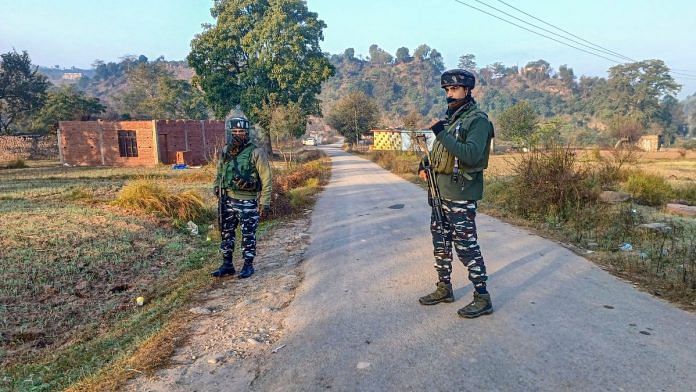New Delhi: The latest encounter in Jammu and Kashmir’s Rajouri area saw five Army soldiers, including two Captain, killed in action. While two terrorists, including a Pakistani with experience of fighting in Afghanistan, were also killed in the encounter, the loss of five soldiers is troubling because it happened in the Rajouri-Poonch area, also known as the Pir Panjal region.
Not only has the region witnessed several encounters with terrorists, what is of major concern is that nearly all of them have followed a similar pattern.
Over the past few months, the Pir Panjal region of Jammu and Kashmir has reported a stark rise in terrorist attacks – at least 30 have been killed in the area this year. According to multiple accounts, the terrorists launch the first wave of attack on security forces and lure them into dense forests bordering Pakistan. Once deep into the treacherous terrain, they regroup and engage the forces in guerrilla warfare.
The pattern, which has emerged as a new terror tactic since 2020, has also brought into question some decisions by military leadership in the area. Former Jammu and Kashmir Chief Minister Farooq Abdullah said after the Poonch attack in April, in which five soldiers were killed, that a possible security lapse needed to be investigated. Some security analysts questioned whether senior officers rushed to the encounter site in haste without an accurate assessment, leading to more casualties.
The rise in terrorist activities in the area after nearly 15 years is cause for concern for India, with Pakistan seen to be fuelling ambushes in an attempt to worsen the Kashmir problem after the nullification of Article 370.
Military experts say it is important for the army leadership to pause and strategise against this new pattern of attacks so that an effective counter can be developed.
This is why these killings are ThePrint’s Newsmaker of the Week.
Also read: This Hizbul militant was seconds away from being shot — then, an Army major stepped in
The pattern
The security forces receive a tip-off that a certain number of terrorists are hiding in the thick jungles. As the forces make their way to the probable site, they are ambushed by the hiding terrorists. More teams that come in to evacuate the injured are also ambushed.
What is shocking is that three of the four soldiers who were killed in the Rajouri operation belonged to the famed 9 Para Special Forces (SF). The 9 Para SF has witnessed a total of eight casualties in the past six months, including the latest deaths.
Even in the latest encounter, it was the 63 Rashtriya Rifles that undertook the operation when their Captain got severely injured. The 9 Para team came in to evacuate the Captain but themselves came under fire from the terrorists, who were believed to be numbered four.
At the wreath-laying ceremony, Northern Army Commander Lt General Upendra Dwivedi, who is the seniormost to take over as the Army chief from General Manoj Pande next year, said that at least 20 to 25 terrorists are operating in twin districts of Rajouri-Poonch.
Admitting that the area has become a terror hub, he said the Army will take at least a year to root out terrorism from the region. “The two terrorists killed seem to have been trained in Afghanistan and other countries and their killing was a major setback to terrorism and its ecosystem,” he said.
The top officer in the Northern Command was referring to the Pakistani terrorist Quari, who the Army said had fighting experience in Afghanistan. Quari is believed to be an expert in Improvised Explosive Devices (IEDs), operating and hiding from caves besides being a trained sniper.
The Army says he has been active in the area along with his group for about a year and is believed to be the mastermind of the Dangri and Kandi attacks.
In the Dangri village attack in Southern Rajouri on 1 January, six civilians were shot dead, including two children. The attack in Kandi happened in May and witnessed the five soldiers of 9 Para SF getting ambushed and killed.
In April, a joint team of the JeM and the LeT had ambushed an Army truck killing five soldiers and later released a video.
Also read: Why did court martial verdict fall apart in Amshipora ‘encounter’ case? This was avoidable
The challenges
Sources in the defence and security establishment explained that one of the biggest challenges in this area is the hilly terrain with forests spread over 4,304 square kilometres.
The Line of Control (LC) goes through many wide gaps through these border districts, making it an excellent choice for infiltration.
However, the area had fallen silent following Operation ‘Sarp Vinash’ in 2003 when the Army eliminated terrorists who had made bases in the Hilkaka Poonch-Surankote area.
But heightened terror activity witnessed since 2020 with multiple intelligence inputs, including the Army’s, indicating the possibility of this area becoming a terror hotspot once again.
The Pir Panjal range, as explained earlier, is a cluster of lower mountains in the Western Himalayas, which extends from the Nilam River in western Pakistan-occupied Kashmir through southwestern J&K, to the Upper Beas River in northwestern Himachal Pradesh. In Jammu, it stretches from Poonch in the west to Doda in the east.
Once a terrorist has entered Rajouri, he can easily trek into Kashmir and reach Kulgam and then Kokernag. In the same manner, Shopian and Uri can be easily reached through Poonch.
Sources also indicated that the transfer of the Uniform Force, a Division-level strength Army formation, to Eastern Ladakh, as reported first by ThePrint, has also had an effect on maintaining a tight counter-terrorism grid.
(Edited by Prashant)



